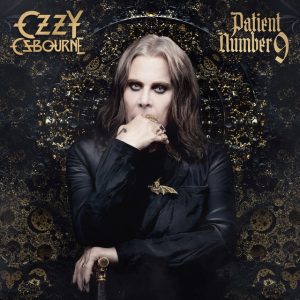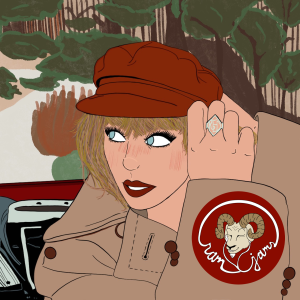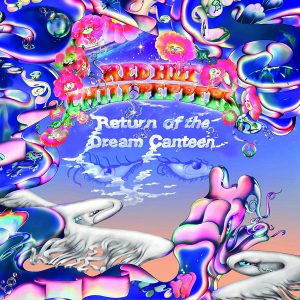Ram Jams: ‘Midnights’ Reinstates Taylor Swift as The Pop Mastermind
The old Taylor can actually come to the phone right now because pop Taylor is back and better than ever
ACCESS HOLLYWOOD VIA WIKIMEDIA COMMONS
Taylor Swift’s “Midnights” perfectly depicts late night intrusive thoughts and human emotions.
November 2, 2022
Genre: Electronic Pop
On a Playlist With: “Being Funny in a Foreign Language,” “Emails I Can’t Send,” “Melodrama”
After a two-year pandemic which led to the creation of “Folklore” and “Evermore,” two alternative albums that steered away from Taylor Swift’s typical genre, pop Taylor is out of the woods with the release of her 10th studio album — “Midnights.”
When announcing the “Midnights” album, Swift described it in an Instagram post as a “collection of music written in the middle of the night, a journey through terrors and sweet dreams.” She strings these nights together with a new sultry, electronic pop sound, which is much darker and experimental because of its inspiration from her “late nights.”
The opening track, “Lavender Haze,” beautifully encapsulates the themes of the album — from love to anxiety, setting the scene for the new cool, calm and collected Taylor. It perfectly opens the album as Swift invites her fans to “meet (her) at midnight.” The title of the song comes from the television series “Mad Men,” and she explained in an Instagram reel that the song describes an “all-encompassing love glow.” Lavender becomes the new “red” for Swifties as she describes her love for her current boyfriend, Joe Alwyn.
The second track, “Maroon,” features the familiar Taylor tropes of love, wine, red, New York, dancing and features of a domestic scene. She sings about cleaning incense off her vinyl shelf, standing hollow-eyed in the hallway, and the classic — dancing with no shoes on. Similar to her title track “Red” off of her fourth album, “Maroon” reminisces of a love that was “so scarlet it was maroon.” While it is more melancholy and mature than “Red,”it consists of the same theme of feeling love and passion through color.
She plays into the same themes from her previous albums in which she analyzes all that is perceived about her, and this album portrays how Taylor absorbs this narrative set upon her.
The album closer, “Mastermind,” wraps it perfectly with her depicting herself as a “Machiavellian” manipulator that orchestrates her relationship and her reputation in the media.
In the lead single, “Anti-Hero,” Taylor divulges her deepest insecurities and fears as she realizes that she is her own worst enemy and that she is the “problem.” It’s a “tale as old as time.” Swift’s vulnerability is nakedly portrayed in the lyrics as she sings about her depression, love life and low self-esteem.
“You’re on Your Own, Kid” similarly narrates Swift’s emotional acuity as she sings about her past struggles with her body image and eating disorder. It also hits close to home for college students transitioning from their teenage years to adulthood and learning to adjust to being alone for the first time.
Although “Snow On the Beach” was disappointing to some fans after finding out that Lana Del Rey’s announced feature only amounts to backup vocals, the song itself is angelic and heavenly as both their voices and harmonies melt into one another, making it strikingly beautiful.
“Karma,” a long-awaited song after Swifties theorized that Swift had a scrapped secret album from 2016 called “Karma,” is exactly what you would expect. She sings about karma getting back around to those who burned her to get where they are. It’s fun and sassy.
In a similar track, “Vigilante Shit,” which features a more hip-hop beat, Swift revisits her common theme of seeking revenge on her enemies, singing that her “pennies made your crown” and that she is going to “draw the cat-eye sharp enough to kill a man.” These two tracks bring Swift to a full circle moment as her revenge is her success.
The album closer, “Mastermind,” wraps it perfectly with her depicting herself as a “Machiavellian” manipulator that orchestrates her relationship and her reputation in the media.
And because Swift has such a great reputation for being direct with her fans, the star “chaotically” released the deluxe version of the album at 3 a.m. that night, calling it “Midnights (3am Edition).” It features songs like “Would’ve, Could’ve, Should’ve,” which fans presume dives into Swift’s alleged relationship with her former boyfriend John Mayer who took her “girlhood” away.
“Dear Reader,” the final bonus track, closes the deluxe album by Swift telling her fans to “never take advice from someone who’s falling apart.” She ends “Midnights” by indicating that she is an unreliable narrator, making the album more cryptic than it already is.
While this album isn’t as cohesive as Swift’s others, it perfectly depicts late night intrusive thoughts. It’s chaotic and all over the place, just like one’s midnight overthinking. Swift beautifully depicts human emotions and its range — from love, to vulnerability, to depression, to yearning for revenge. Isn’t that what life is all about?
The Bottom Line: This is a sexier older sister to “Lover,” and she’s way more fun and chaotic.
The Peaks: “Maroon,” “Karma,” “Anti-Hero” and “Paris”
The Valleys: “Bejeweled” and “Snow On The Beach”
The Verdict: 10/10















